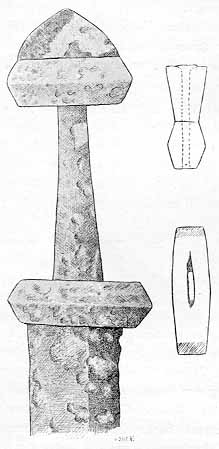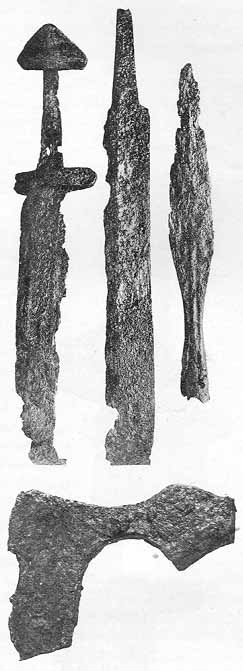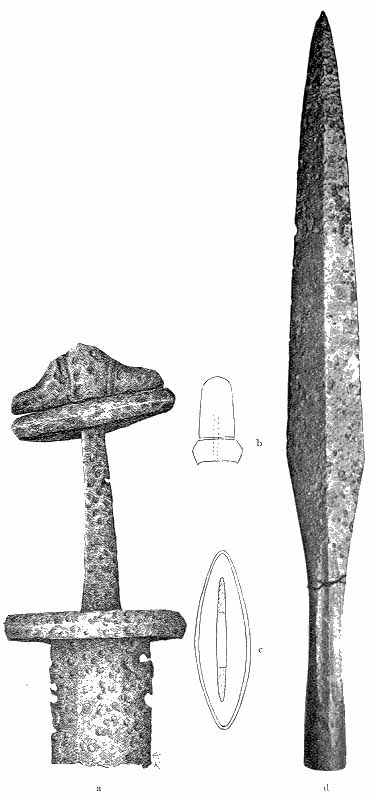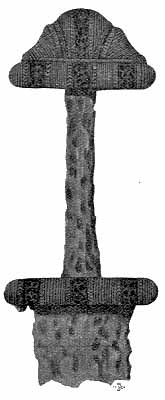

The guards are short, high, ridged, [and] with a four-sided cross-section, widest in the middle. The pommel is three-sided and of uniform width. Guards and pommel are without metal covering or other ornamentation. The pommel, which is massive, was never attached to the upper guard with rivets, but rather done in a similar fashion to the previous type. The type makes quite an immense impression, even though the next one seems even heavier.
I know 22 specimens from this country [Norway]. Of those, 14 are double-edged and 8 single-edged. One of the blades has damascene marking, another seems to be damascened [pattern-welded] all the way through; otherwise they are without damascening or inscription. The distribution is as follows:
|
|
|
|
|
| Hedem. |
|
|
|
| Krist. |
|
|
|
| Busk. |
|
|
|
| Brb. |
|
|
|
| S.B. |
|
|
|
| N.B. |
|
|
|
| Rmsd. |
|
|
|
| S.T. |
|
|
|
| N.T. 3 1 4 |
|
|
|
|
|
|
|
|
|
|
|
|
It is, as one can see, mainly a trøndersk [from Trøndelag] and vestlandsk [from western Norway] type. From Hedemarken there is only one specimen, and one from Vestoplandene. The other specimen from Kristians county is from Valdres. However, the type also has a wider distribution. I know it in two specimen from Finland[2], likewise in several specimens from Sweden: Gotland, Gestrikland, Uppland and one sword in Gøteborgs museum (nr. 2442). Probably nr. 6375 in Nationalmuseet in Copenhagen belongs to the same type. Finally it exists in Germany, in Schleswig - Holstein[3] and in Ditmarsken[4], where there is an arrowhead of a pronounced type B as in the Norwegian find.[61]
Next we shall look at the placement in time of this type. Those weapons that appear together with swords of this type are axes of type A, B and C. In one find (B 3987 Bryni, Vangen s. Voss), where there, by the way, appears a sword of type C, there is an ax of type D. Of spearheads, there is a spear with furrows on the shaft and on the lower part of the blade in one find (B 3967 Vikevik, Sveen, fig. 54 ). In the same find there are 2 single-edged swords without guards. In another find, there are spears of type B. The shields are all (9 specimens in 2 finds) of type R 564. In one find from Nordmøre (T 6549) there are spearheads without a distinctive edge between the blade and the pin. Finally there is in one find (C 20314, Arstad, Stange), a rattle of the oldest kind. It has less significance that there in a find (B 1848-52) is a spear of type F, when there also is a sword of type H.

The determination of dates should become apparent based on the material available for comparison. Most of the material combinations of the finds will indicate that we have a type from the 7th Period. This is supported by the ax groups A, B and C found together with a spearhead with furrows and the single-edged sword and the rattle. Likewise, this is confirmed in a splendid way by a find from Finland, one of the aforementioned from the Praehistorische Zeitschrift and Finskt Museum, where there was found a shield of genuine Vendel type together with the sword. This find is also dated, by Hackmann, to the transitional period between the Migration Period and the Viking Age. On the other hand, Lindenschmit dates the above mentioned sword from Ditmarsken, to the 9th Century. This find is otherwise composed in a similar way to the Norwegian finds, with a spearhead of my type B, and with stirrups of the oldest type. There is support everywhere for the opinion that the type belongs to the 7th Period.[~62] Even the arrowheads are of the same type as those that appear together in a genuine 7th Period’s weapons find. The only find that definitely show that the type must belong to the latter part of the 7th Period, and even could have been present at the beginning of the Viking Age, is B 3987 from Bryni, Vangen s. Voss, where a sword of type C and furthermore axes of type D were found together with this sword. This shows that the find otherwise, in its entirety, is from the Viking Age, and that type B must be considered an antiquated type in the find. It is quite evident that type C, which belongs to the Viking Age entirely, is a direct typological development from type B, and shows that type B must belong to the latter part of the previous period [preceeding the Viking Age].
The origin of the type has not been made clear because of this, and because of its distribution this will be difficult to determine. It has most likely, just like the previous, developed through a simplification of sword pommels from the older Iron Age. We seem to have an indication of this in the sword T 11547 from Marienlyst, Strinden, S.T., where there seems to be a slight indentation in the pommel.

C 19809. Double-edged sword, S. Skjønne, Nore, Busk. Upper hilt in two pieces [having a distinctly separate upper guard and pommel]. The pommel is highest in the middle with lower sections on the sides. The guards are ridged and concave on the top and bottom. It is lacking ornamentation. [63]
The sword was found together with an ax blade of type A and a spearhead like R 520, with furrows on the shaft and on the lower part of the blade (fig. 55d). The same sword type belongs possibly to C 1878 from Mela, Gjerpen, found with a tall shield like R 564.
The sword should be considered a simplification of types from the Migration Period, with pommels having a taller middle section and with animal heads on the sides. Other types with a taller middle section could also have been simplified in this way, but the explicit tripartite [pommel] profile on our sword seems to point to the first of these types. A sword like Sophus Müller: Vor Oldtid p. 656 fig. 407 could have been the prototype for our sword. It is very close in appearance to the sword C 20317a from Steinsvik, Hol s., Lodingen, which surely belongs to the period around the change of the century, with early "karolingisk" ornamentation, and found together with an ax of type C (fig. 56). We must however [look] further back in time than this type. Our sword is, as you see, found together with an ax and spear that point to [it] being older than the Viking Age. The spear is of the same type as the one H. Schetelig has just depicted in "Nye Jernaldersfund paa Vestlandet" p. 79 fig. 104, where they found single-edged swords without guards, a usual combination in finds from the 7th Period. We have therefore a sword that does not actually belong to the Viking Age, but is nevertheless of interest in that it shows that already at this point in time a domestic [Norwegian] simplification of the sword hilts began, so common during the Viking Age, a point we shall hear about more frequently. That such a sword has been found high up in Numedal, also fits with what we later shall learn. [65]

[1] See also Oldtiden VII p. 114 and fig. I. Jan Petersen: "En norsk sverdtype fra vikingetiden". That the number of swords have almost been doubled since my inventory at that time is explained by the fact that the "Trønderske" material has increased, partly due to new acquisitions, and partly due to closer investigation in the museum. It is also possible that several of the swords that are lacking upper hilts, but that have the lower guard such as this and following types, also belong to the B-type. [return]
[2] See Praehistorische Zeitschrift VI, p.156, fig. 59 and 62 and in Finsk Museum 1914, p. 56. [return]
[3] J. Mestorf: Vorgeschichtliche Altertümer aus Schleswig-Holstein Taf. LVI 690. [return]
[4] Landenschmit: Die Altertümer unserer heidnischen Vorzeit. B IV Taf. 23. Grabfund bei Immenstadt, Ditmarschen. [return]